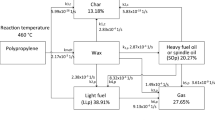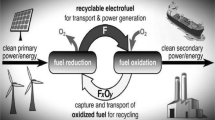Abstract
This paper presents a study of the macrokinetic regularities of combustion and thermal decomposition kinetics of energetic condensed compositions containing high-enthalpy high-nitrogen compounds based on the system of furazan, furoxan, and azepine cycles and poly-2-methyl-5-vinyltetrazole as an active binder. The linear rates of high-temperature transformations (combustion) of compositions with different ratios of components were determined in the nitrogen pressure range 1–6 MPa. The burning rate of compositions of polycyclic compounds and poly-2-methyl-5-vinyltetrazole was found to exceed the burning rate of individual components, with the synergistic effect increasing as the nitrogen pressure in the system is decreased. Kinetic studies of heat release during thermal decomposition of energetic compositions in the temperature range 50–350°C under isothermal and nonisothermal conditions showed that in pressed compositions, there was interaction between the reactants leading to a significant increase in the rate of thermal decomposition of the mixture relative to the rate of decomposition of individual components. The data obtained indicate that one of the reasons for an increase in the burning rate upon mixing of components may be a change in the burning-rate controlling reactions due to the chemical interaction of components of the binary composition.









Similar content being viewed by others
REFERENCES
M. B. Talawar, R. Sivabalan, M. Anniyappan, et al., “Emerging Trends in Advanced High Energy Materials," Fiz. Goreniya Vzryva 43 (1), 72–85 (2007); Combust. Expl. Shock Waves 43 (1),62–72 (2007); https://doi.org/10.1007/s10573-007-0010-9].
M. A. Suntsova, “Prediction of Enthalpies of Formation of New Nitrogen-Containing Energetic Compounds Based on Quantum-Chemical Calculations," Candidate’s Dissertation in Chem. Sci. (Moscow State Univ., Moscow, 2016); http://www.dslib.net/ fiz-xim/prognozirovanie-jentalpij-obrazovanijanovyh-azotsoderzhawih-vysokojenergeticheskih.html.
T. M. Klapotke, Energetic Materials Encyclopedia (De Gruyter, Berlin–Boston, 2018).
S. G. Zlotin, A. M. Churakov, M. P. Egorov, L. L. Fershtat, M. S. Klenov, I. V. Kuchurov, N. N. Makhova, G. A. Smirnov, Y. V. Tomilov, and V. A. Tartakovsky, “Advanced Energetic Materials: Novel Strategies and Versatile Applications," Mendeleev Commun. 31 (6), 731–749 (2021); DOI: 10.1016/j.mencom.2021.11.001.
A. A. Dippold, D. Izsák, and T. M. Klapötke, “A Study of 5-(1,2,4-Triazol-C-yl)tetrazol-1-Ols: Combining the Benefits of Different Heterocycles for the Design of Energetic Materials," Chem. Eur. J. 19 (36), 12042–12051 (2013); DOI: 10.1002/chem.201301339.
T. M. Klapötke and T. G. Witkowski, “Nitrogen-Rich Energetic 1,2,5-Oxadiazole-Tetrazole–Based Energetic Materials," Propell., Explos., Pyrotech. 40 (3), 366–373 (2015); DOI: 10.1002/prep.201400294.
V. P. Sinditskii, A. D. Smirnova, V. V. Serushkin, N. V. Yudin, I. A. Vatsadze, I. L. Dalinger, V. G. Kiselev, and A. B. Sheremetev, “Nitroderivatives of N-pyrazolyltetrazoles: Thermal Decomposition and Combustion," Thermochim. Acta 698, 178876 (2021); DOI: 10.1016/j.tca.2021.178876.
H. Huang, Z. Zhou, L. Liang, J. Song, K. Wang, D. Cao, Ch. Bian, W. Sun, and M. Xue, “Nitrogen-Rich Energetic Dianionic Salts of 3,4-Bis(1H-5-tetrazolyl)furoxan with Excellent Thermal Stability," Z. Anorg. Allg. Chem. 638 (2), 392–400 (2012); DOI: 10.1002/zaac.201100470.
A. A. Astrat’ev, D. V. Dashko, and A. I. Stepanov, “Unusual Reaction of 3,4-Bis(3-nitrofurazan-4-yl) Furoxan with Ammonia, Primary Amines and Hydrazine," Centr. Eur. J. Chem. 10 (4), 1087–1094 (2012); DOI: 10.2478/s11532-012-0020-7.
L. S. Yanovskii, D. B. Lempert, V. V. Raznoschikov, and I. S. Averkov, “Evaluation of Effectiveness of Solid Fuels Based on High Enthalpy Dispersants for Rocket Ramjet Engines," Zh. Prikl. Khim. 92 (3), 322–342 (2019) [Russ. J. Appl. Chem. 92, 367–388 (2019); https://doi.org/10.1134/S1070427219030078].
A. F. Zholudev, M. B. Kislov, I. S. Averkov, D. V. Dashko, V. V. Raznoschikov, D. B. Lempert, and L. S. Yanovskiy, “Features of Combustion of Gas-Generating Solid Compositions Based on High-Enthalpy Dispersants," Izv. Ross. Akad. Nauk, Ser. Khim. 70 (4), 685–692 (2021) [Russ. Chem. Bull. 70, 685–692 (2021); https://doi.org/10.1007/s11172-021-3137-z].
N. N. Volkova, D. V. Dashko, A. F. Zholudev, M. B. Kislov, and L. S. Yanovskii, “Regularities of the High-Temperature Transformation of Poly-2-methyl-5-vinyltetrazole and Solid Fuel Compositions Based on It in the Nitrogen Atmosphere," J. Phys.: Conf. Ser. 1891, 012059 (2021); DOI: 10.1088/1742-6596/1891/1/012059.
B. V. Nedel’ko, B. P. Roshchupkin, T. S. Larikova, L. N. Shumakova, N. A. Afanas’ev, B. L. Korsunskii, N. A. Pavlov, E. V. Fronchek, and G. V. Korolev, “Thermal Destruction of Poly-2-methyl-5-vinyltetrazole," Vysokomol. Soed. B28 (9), 681–686 (1986).
D. R. Cruise, “Theoretical Computations of Equilibrium Compositions, Thermodynamic Properties, and Performance Characteristics of Propellant Systems," Report No. NWC-TP-6037 (Naval Weapons Center, China Lake, 1979).
C. Fang and S. Li, “Synergistic Interaction between AP and HMX," J. Energ. Mater. 20 (4), 329–344 (2002); DOI: 10.1080/07370650208244827.
A. N. Pivkina, N. V. Muravyev, K. A. Monogarov, V. G. Ostrovsky, I. V. Fomenkov, Yu. M. Milyokhin, and N. I. Shishov, Synergistic Effect of Ammonium Perchlorate on HMX: from Thermal Analysis to Combustion, Chemical Rocket Propulsion. A Comprehensive Survey of Energetic Materials, Ed. by L. De Luca, T. Shimada, V. Sinditskii, and M. Calabro (Springer, Switzerland, 2017), Chapter 15, pp. 365–381.
B. V. Golovko, A. A. Kopeika, and E. A. Nikitina, “Features of Thermal Explosion with Parallel Reactions," Fiz. Aerodisp. Sist., No. 40, 64–70 (2003).
N. M. Emanuel’ and D. G. Knorre, Course of Chemical Kinetics (Vysshaya Shkola, Moscow, 1969) [in Russian].
A. I. Kazakov, D. B. Lempert, A. V. Nabatova, D. V. Dashko, V. V. Raznoschikov, L. S. Yanovsky, and S. M. Aldoshin, “Kinetic Fundamental Aspects of Heat Release in Thermal Decomposition 7-Amino-7H-difurazano[3,4-b:3′,4′- f]furoxano [3″,4″-d]azepine and Binary Fuel on Its Basis," Zh. Appl. Chem. 92 (S13), 1657–1665 (2019); DOI: 10.1134/S0044461819130036 [Russ. J. Appl. Chem. 92, 1696–1704 (2019); https://doi.org/10.1134/S1070427219120101].
N. N. Volkova and V. G. Prokudin, “Kinetics and Mechanism of Thermal Decomposition of Poly-1(2)-methyl-5-vinyltetrazoles," in Abstracts XI Meetings on the Kinetics and Mechanism of Reactions in Solids, 1992, pp. 349–352.
A. V. Zuraev, Yu. V. Grigor’ev, I. M. Grigor’eva, L. I. Pan’ko, L. S. Ivashkevich, A. S. Lyakhov, and O. A. Ivashkevich, “Synthesis and Thermolysis of Copper Poly-5-vinyl Tetrazolate," Zh. Belorus. Gos. Univ. Khim., No. 1, 67–75 (2018).
A. I. Lesnikovich, V. V. Sviridov, P. N. Gaponik, V. P. Karavai, G. M. Tseloval’nikova, M. M. Degtyarik, and S. V. Vyazovkin, “Capability of High-Nitrogen Compounds for Self-Propagating Thermolysis," Dokl. Akad. Nauk BSSR 29 (9), 824–827 (1985).
O. A. Ivashkevich, Thermal Decomposition and Combustion of Tetrazole Derivatives, Chemical Problems of Designing New Materials and Technologies, Ed. by V. V. Sviridov (Belarus. Gos. Univ., Minsk, 1998), pp. 215–236.
A. I. Lesnikovich, G. V. Printsev, O. A. Ivashkevich, V. A. Lyutsko, and K. K. Kovalenko, “Tetrazole Combustion," Fiz. Goreniya Vzryva 24 (5), 48–51 (1988) [Combust. Expl. Shock Waves 24, 549–551 (1988); https://doi.org/10.1007/BF00755492].
V. P. Sinditskii, V. Yu. Egoryshev, V. V. Serushkin, A. E. Fogel’zang, and V. I. Kolesov, “Combustion Mechanism of Tetrazole Derivatives," Khim. Fiz. 18 (8), 87–94 (1999).
P. I. Kalmykov, V. N. Simonenko, A. B. Kiskin, V. E. Zarko, K. A. Sidorov, and R. G. Nikitin, “Investigation of Combustion of Model Compositions Based on FTDO, DNP, and Tetrazole Copolymer," in Abstracts XV All-Russian Symp. on Combustion and Explosion (2020), Vol. 2, pp. 115–116
Author information
Authors and Affiliations
Corresponding author
Additional information
Translated from Fizika Goreniya i Vzryva, 2022, Vol. 58, No. 4, pp. 5-15.https://doi.org/10.15372/FGV20220401.
Rights and permissions
About this article
Cite this article
Volkova, N.N., Dashko, D.V., Zholudev, A.F. et al. Combustion and Thermal Decomposition of Solid Gas-Generating Compositions Based on High-Enthalpy Poly-N-Heterocyclic Compounds and Poly-2-Methyl-5-Vinyltetrazole. Combust Explos Shock Waves 58, 397–407 (2022). https://doi.org/10.1134/S0010508222040013
Received:
Revised:
Accepted:
Published:
Issue Date:
DOI: https://doi.org/10.1134/S0010508222040013




